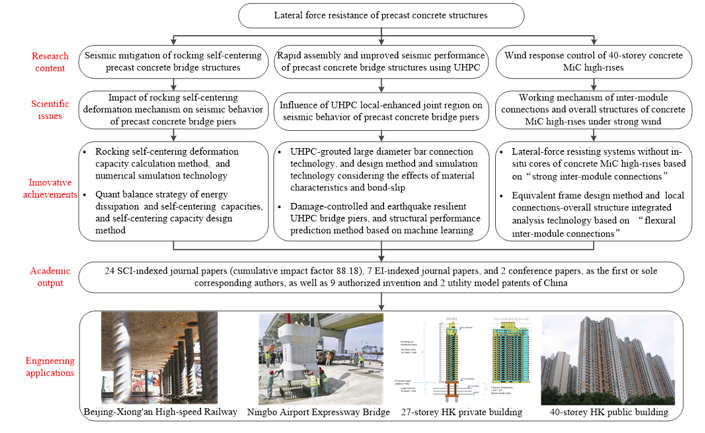Video Article Open Access
Lateral Force Resistance of Precast Concrete Structures -New Material, New Structure, and New Construction
Zhen Wang1,2,*, Wei Pan1, Jingquan Wang2, Yang Zhang1, Tongxu Liu2,3, Jian Zhang4
1The University of Hong Kong, Hong Kong, 999077, China
2Southeast University, Nanjing, 218889, China
3Polytechnique Montréal, Montreal, QC H3C 3A7, Canada
4University of California, Los Angeles, CA 90095, United States
Vid. Proc. Adv. Mater., Volume 3, Article ID 2206294 (2022)
DOI: 10.5185/vpoam.2022.06294
Publication Date (Web): 13 Sep 2022
Copyright © IAAM
Graphical Abstract

Abstract
Precast concrete structures are being popularized worldwide due to the advantages in terms of accelerated construction, low-carbon, high-quality production, and environment-friendly. Due to the existence of in-situ connections, some concerns focused on the overall structural integrity of precast concrete structures under lateral loadings such as seismic and wind loadings. My studies aim to adopt the combination of high-performance concrete material, novel structural types, and advanced construction methods to ensure the structural integrity of bridge structures and high-rises under lateral loadings. For bridge structures, when precast concrete bridge piers adopt post-tensioning tendons and grouted connection bars to assemble individual segments into a structural whole, they present rocking self-centering deformation mechanism and certain energy dissipation capacity under strong earthquake. A series of experimental studies and theoretical analyses were conducted to investigate the impact of rocking self-centering deformation mechanism on the seismic behavior of the bridge piers. According to the results, the rocking self-centering deformation capacity calculation method was established, as well as the self-centering capacity design method was developed based on the quant balance strategy of energy dissipation and self-centering capacities. Ultra-high-performance concrete (UHPC) was applied to precast concrete bridge piers, as grout to connect large-diameter bars for rapid assembly, and as construction material to directly build the joints that are easy to be compressively crushed for improved seismic performance. Systematic trial and theoretical studies were done to research the influence of UHPC local-enhanced joint region on the seismic behavior of the bridge piers. Following the studies, the UHPC-grouted large diameter bar connection technology and the relevant design method were developed, as well as new damage-controlled and earthquake resilient UHPC bridge piers were proposed. In addition, machine learning was utilized to predict the structural performance of precast concrete structures that adopt UHPC in their critical joints. For high-rises, modular integrated construction (MiC) was adopted to construct them up to 40-storey height. Numerical studies and theoretical analyses were conducted to explore the working mechanism of inter-module connections and overall structures under strong wind. Lateral-force resisting systems without in-situ cores were put forward and numerically validated based on the design concept of “strong inter-module connections”, while equivalent frame design method and local connections-overall structure integrated analysis technology were developed based on the design concept of “flexural inter-module connections”. All the above studies using new material, new structure, and new construction contribute to improving the lateral force resistance of precast concrete structures, and their useful results have been applied to actual engineering structures.
Keywords
Precast concrete; self-centering; ultra-high-performance concrete; earthquake resilience; modular integrated construction.
Acknowledgement
The work presented was supported by a grant from the Research Impact Fund of the Hong Kong Research Grants Council (HKU R7027-18), the National Natural Science Foundation of China (U1934205, 51438003), and the Project of Science and Technology Research and Development Plan of China Railway Corporation (2017G006-C).
References
- J. Q. Wang, J. P. Liu, Z. Wang, T. X. Liu, J. Z. Liu, J. Zhang, Journal of Bridge Engineering, 2021, 26(2), 04020117.
- Z. Wang, J. Q. Wang, Y. C. Tang, Y. F. Gao, J. Zhang, Journal of Bridge Engineering, 2019, 24(3), 04018124.
- Z. Wang, J. Q. Wang, Y. C. Tang, T. X. Liu, Y. F. Gao, J. Zhang, Engineering Structures, 2018, 177, 540-555.
- Z. Wang, W. Pan, Y. Zhang, Engineering Structures, 2021, 241, 112436.
- Z. Wang, W. Pan, Journal of Building Engineering, 2020, 31, 101355.
Biography
Under the supervision of Professor Wang Jingquan, I received my Ph.D. from School of Civil Engineering, Southeast University, in 2018. After that, I joined in Department of Civil Engineering, The University of Hong Kong, and work so far as a post-doc fellow in Professor Pan Wei’s research group. As a young scientist, my research interests concentrate on the combination of precast concrete structures with ultra-high-performance concrete (UHPC), earthquake-resilience, self-centering characteristics, modular integrated construction (MiC), and machine learning, which is an international research hotspot. I have long been committed to the applied fundamental research on the seismic mitigation and disaster-proof of precast concrete structures. In detail, my research scope includes but is not limited to self-centering and earthquake-resilient precast concrete bridge structures, rapid assembly technology of UHPC local-enhanced precast concrete bridge structures, innovative structural systems and connections of concrete MiC high-rises, and data-driven prediction models of precast concrete structures using machine learning approach. Based on the above studies, I have published 24 SCI-indexed journal papers (cumulative impact factor 88.18), 7 EI-indexed journal papers, and 2 conference papers, as the first or sole corresponding authors, as well as received 9 authorized invention and 2 utility model patents of China. The research achievements have been applied to Beijing-Xiong'an High-speed Railway, Ningbo Airport Expressway Bridge, Hong Kong public housing and private buildings, etc. I was nominated for T.Y. Lin Award from the American Society of Civil Engineers (only 3 nominees annual) and awarded Jiangsu Province Excellent Doctoral Dissertation (the only one in the field of civil and structural engineering).
Video Proceedings of Advanced Materials

Upcoming Congress



